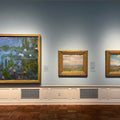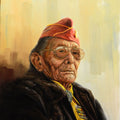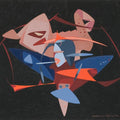Chihuly, Calder and the Northwest Coast: Art Across Seattle
By Chadd Scott on
I hadn’t been to Seattle in over 20 years before returning for a tour of the Seattle Art Museum’s new Alexander Calder exhibition in November of 2023. I was looking forward to binging as much art as possible on my five-day visit.
I try to be cost conscious and carbon conscious when traveling. Not always easy, sometimes not even possible. The best way to achieve both is by using mass transit.
With no advance preparation, I was easily able to use Seattle’s various light rail, monorail and streetcar lines to navigate my way quickly and inexpensively around the downtown core. The systems are single line making them super easy to figure out and simple to use.

Alexander Calder's 'The Eagle' sculpture with Space Needle in background | Photo by Chadd Scott
I’m guessing I saved $1,000 on rental car and parking fees, or half that much on Uber rides, taking mass transit. This starts at the airport where a walk of a couple hundred yards – it’s covered – puts visitors at the Link Light Rail station; $3.50 brings you downtown. Taxi or rideshare would be $50 for the same ride, at least, depending on traffic and demand.
Mass transit can’t save the world, put it’s near the top on the list of solutions which can. So are vibrant downtowns, and I was happy to find most of Seattle’s art highlights within a mile of each other downtown, all accessible via mass transit or on foot.
W Seattle
The W Seattle hotel downtown makes a perfect home from which to base your artistic explorations of the Emerald City. Just two blocks from the University Street underground Link station, the W Seattle offers luxury without pretention.
The property is distinguished by its “Faces” rooms.
During the pandemic, resident artist Morgan Zion hand painted 10 murals of ‘faces’ she felt best represented the city and its unique neighborhoods on the hotel’s 14th Floor. Each mural incorporates a QR code leading to a landing page filled with suggestions by that “face” of where to eat, shop and what to see in their neighborhood.
Zion was on her way back to Southern California in the pandemic’s early days when she approached the hotel about her idea for creating murals inside the guest rooms. The hotel was game, and since it was empty due to COVID, Zion had the run of the place, also completing murals in the hotel’s valet area and restaurant.

W Seattle Faces room | Photo by Chadd Scott
She considers the murals “a love letter to Seattle,” an attempt to encourage visitors to experience the city beyond its typical tourist attractions. The “Stella” room, where Zion stayed during the pandemic, was the first to be completed.
“Faces” rooms can be booked starting in the $200s midweek and offseason.
Keep an eye out for Zion around the hotel. She continues teaching yoga classes there.
W Seattle’s interest in the arts extends beyond the visual to the audial. It is the first hotel in North America with a working recording studio: the Sound Suite.
Guests can channel their inner Jimi Hendrix or Kurt Cobain – Hendrix was born in Seattle, Cobain rose to fame there – in a suite decked out with a functioning sound booth and multi-channel, digital mixing board. If you don’t want to lay down any tracks, but still have the music in you, the room can be rented for listening parties, movie nights, cocktail hour, video games, photo shoots – you name it.
https://www.youtube.com/watch?v=ryBZBuQkfK0
W Seattle highlights live music throughout the year with its free Main Stage performances showcasing up-and-coming regional bands playing in the hotel the first Friday of every month, except December. W After Dark is a DJ Series where guests can dance the night away to mixes from Seattle DJ’s in the hotel’s Living Room Bar on Fridays and Saturdays starting at 9PM.
Dale Chihuly
Seattle is the glass art capital of America. This reputation traces back to the founding of the Pilchuck Glass School in 1971 by the singular household name of glass art: Tacoma native Dale Chihuly.
From the ceiling of the Bellagio hotel in Las Vegas to his monumental Lime Green Icicle Tower at the Museum of Fine Arts, Boston, if you’ve seen a glass art sculpture or exhibition in a premier art museum or botanical garden across America, it’s probably been Chihuly.
Chihuly’s school 60 miles north of downtown Seattle served as the catalyst that created an epicenter of glass. Pilchuck grew into a top international destination for glass art education, drawing masters of the art form, many of whom stayed in the area.

View of the Space Needle from the Chihuly Gardens and Glass Glasshouse | Photo by Chadd Scott
Today, more than 700 glass artists live in Washington. More than 100 glass art studios make their home in the region, a higher concentration than anywhere else in the U.S.
Seattle reaffirms its status at the top of the glass art heap each October hosting “Refract: The Seattle Glass Experience.” The captivating fusion of color, heat, light, and passion for this mesmerizing art form spreads out not only across the city, but the region, through an array of exhibitions, studio tours, live demonstrations, and unique opportunities to engage with a new generation of glass artists.
The best way to experience Seattle glass art the rest of the year comes at Chihuly Garden and Glass at the Seattle Center. Here, visitors can see a dazzling selection of room-filling Chihuly masterpieces along with daily glassblowing demonstrations.
Be sure to visit the Glass House in the shadow of the Space Needle for incredible views of the spire from beneath, framed with Chihuly’s artwork in the foreground. Spectacular!
General adult admission is a stiff $35. If you plan on including the full tourist itinerary on your visit to Seattle – Chihuly, Space Needle, aquarium, zoo, etc. – purchasing a Seattle CityPASS is the way to go for steep admission discounts. For an arts focused visit, the Seattle C3 deeply discounts admission to Chihuly Garden and Glass, the Seattle Art Museum, and the Museum of Popular Culture next door to Chihuly. Compare, contrast and purchase here.
Speaking of MoPOP – Museum of Popular Culture – I wasn’t expecting much when I visited, but had a blast. Permanent exhibitions for Nirvana and Hendrix are joined by temporary exhibitions covering music, film, TV, gaming – all the fun stuff.
Chihuly, MoPOP, and the Space Needle are located at the Seattle Center, easily accessible via the Seattle Center Monorail tracking back and forth from the Westlake Center transit station four blocks from the W Seattle and two blocks from iconic Pike Place Market. Adult tickets cost $3.50.
It’s a little over a mile to walk from W Seattle to the Seattle Center. I enjoyed the stroll to see the city at street level, but if it’s raining, you’re with kids, or have mobility challenges, the Monorail is the way to go.
Seattle Art Museum
Native art from the Northwest Coast has been part of the Seattle Art Museum since the 1950s. Between 1983 and 1985, John H. Hauberg donated about 30 objects to the small collection. In 1991, the contribution of the remainder of the Hauberg Collection, considered one of the finest private collections of Northwest Coast art in the world, transformed the museum’s holdings into a major regional collection of Native American art.
Hauberg spent over 40 years amassing the 188 pieces he eventually donated. They consist of a broad range of masks, sculpture, textiles, and household objects from the Pacific Northwest, British Columbia, and Alaska. The collection includes four spectacular full-scale Kwakwaka’wakw (Kwakiutl) carved houseposts, a Tlingit dance screen and Haida argillite carvings.

Northwest Coast art gallery display at Seattle Art Museum | Photo by Chadd Scott
The museum continues to expand its Northwest Coast holdings, including the work of contemporary artists among First Peoples.
In addition to art of the Northwest Coast and the new Calder initiative, SAM’s Aboriginal art from Australia gallery tops any presentation I’ve ever seen of that artwork.
SAM’s presence extends to its Olympic Sculpture Park, downtown’s largest green space one mile north of the museum building. Highlighting the presentation is Calder’s monumental orange The Eagle (1971) sculpture, a six-ton, 38-foot-tall giant.
The park’s elevated prominence along the waterfront with views out over Elliot Bay in one direction, and the Space Needle and downtown skyline in the other, provides dramatic 360-degree vistas. The park is open sunrise to sundown daily with free entry.
Adjacent to the main SAM location downtown, find Eighth Generation, a retail shop owned by the Snoqualmie Tribe offering a selection of authentic Native made and designed products from jewelry to blankets, clothes, candles, soaps, prints and more. Perfect for gifts and souvenirs. As is the Seattle Glassblowing Studio downtown. For bigger ticket fine art, stop by Steinbrueck Native Gallery next to Pike Place Market.
Gallery junkies will dig Pioneer Square a half mile from W Seattle. It’s first Thursday art walk is one of the longest running in the nation.
Asian Art in Downtown Seattle
The Seattle Art Museum’s collection of Asian art can be found at the Seattle Asian Art Museum two miles out of downtown in Volunteer Park.
One mile from W Seattle and conveniently accessible via Link Light Rail and streetcar is North America’s only pan-Asian American and Pacific Islander Museum, the Wing Luke Museum.
Located in Seattle’s vibrant Chinatown-International district, consider taking one of its many tours which include neighborhood walking and food excursions. The museum’s Japanese American Remembrance Trail includes more than 40 stops and can be experienced self-guided. There’s no better do-it-yourself introduction to the neighborhood and this critical aspect of Seattle, and American, history.



